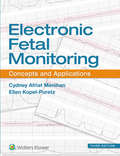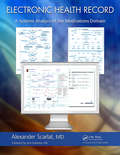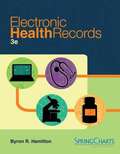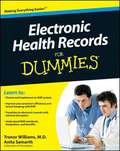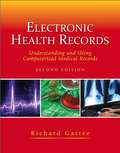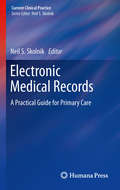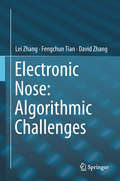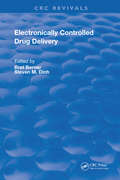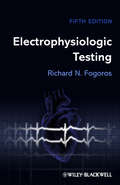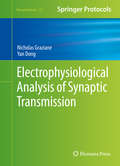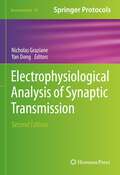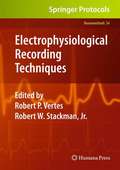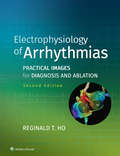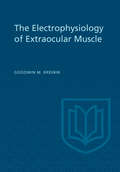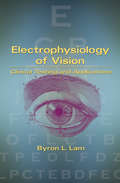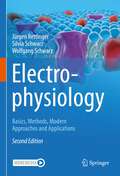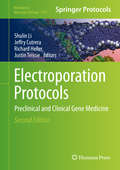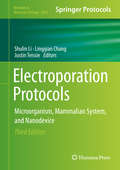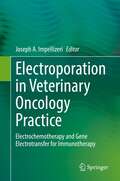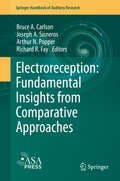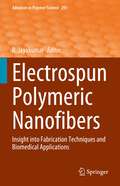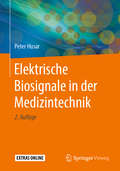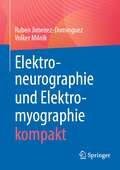- Table View
- List View
Electronic Fetal Monitoring: Concepts and Applications
by Cydney A. MenihanPublisher's Note: Products purchased from 3rd Party sellers are not guaranteed by the Publisher for quality, authenticity, or access to any online entitlements included with the product. The newly updated Electronic Fetal Monitoring: Concepts and Applications, 3rd Edition, is an invaluable guide for clinicians (nurses, nurse-midwives, physicians) responsible for ordering, initiating, performing, and interpreting electronic fetal monitoring (EFM). Written by OB/GYN nurses and advanced practitioners, this combination textbook/workbook offers clinicians involved in perinatal care a uniquely detailed, in-depth, and historical perspective on EFM. Topics include maternal-fetal physiology, EFM instrumentation, antepartum and intrapartum fetal assessment and pattern interpretation, and a variety of additional issues and challenges relevant to the current state of EFM practice. Applicable to both the novice and seasoned practitioner, this text is useful as a both a primer for this specialty field and also as a detailed resource to ready for the NCC Certificate of Added Qualification in EFM. Upgrade and update your EFM skills with: Examples of EFM tracings that demonstrate the points presented in the text– including 22 case studies annotated with real-time bedside interpretation, followed by expert review with commentary to support these analyses. Validation of knowledge - New! End-of-chapter study questions and answers are a perfect supplement for certification exam preparation. For the educator, methods of competence validation are discussed and presented in detail. Up-to-date EFM guidelines - explained and demonstrated in real-life, situational context Concise, easy-to-follow support for optimal acquisition and assessment of EFM data, and proper response to findings. Expert advice on handling both clinical and instrumental challenges related to EFM. Detailed explanation of the workings of EFM equipment and technology. Proven algorithms for management of antepartum testing and of EFM data, outlining specific interventions and their rationales. Coverage of crucial knowledge, including maternal-fetal physiology of fetal heart rate patterns and management of unusual EFM tracings, common problems and more. Chapter features include helpful tips (“Stork Bytes”) to highlight important points. Your book purchase includes a complimentary download of the enhanced eBook for iOS™, Android™, PC, and Mac. Take advantage of these practical features that will improve your eBook experience: The ability to download the eBook on multiple devices at one time—providing a seamless reading experience online or offline Powerful search tools and smart navigation cross-links that allow you to search within this book, or across your entire library of VitalSource eBooks Multiple viewing options that enable you to scale images and text to any size without losing page clarity, as well as responsive design The ability to highlight text and add notes with one click About the Clinical Editors Cydney Afriat Menihan, CNM, MSN, RDMS, is a Nurse Midwife and Perinatal Consultant in North Kingstown, Rhode Island. Ellen Kopel, RNC, MS, is a Nurse Educator and Perinatal Consultant in Tampa, Florida.
Electronic Health Record: A Systems Analysis of the Medications Domain
by MD, Alexander ScarlatAn accessible primer, Electronic Health Record: A Systems Analysis of the Medications Domain introduces the tools and methodology of Structured Systems Analysis as well as the nuances of the Medications domain. The first part of the book provides a top-down decomposition along two main paths: data in motion workflows, processes, activities, and tas
Electronic Health Records (Third Edition)
by Byron Hamilton Leesa HamiltonHamilton, Electronic Health Records, 3e is the top choice for training students using live and up-to-date SpringCharts EHR software. Electronic Health Records 3e builds transferable medical documentation skills with a variety of exercises that walk students through different facets of using an EHR in the medical office. As students progress through SpringCharts, they learn to gather patient information, schedule appointments, record examination information, process lab tests, select codes, and more. Students who complete this course will learn the appropriate terminology and skills to use any EHR software program with minimal additional training. The practical, systematic approach is based on real-world medical office activities.
Electronic Health Records For Dummies
by Anita Samarth Trenor WilliamsThe straight scoop on choosing and implementing an electronic health records (EHR) systemDoctors, nurses, and hospital and clinic administrators are interested in learning the best ways to implement and use an electronic health records system so that they can be shared across different health care settings via a network-connected information system. This helpful, plain-English guide provides need-to-know information on how to choose the right system, assure patients of the security of their records, and implement an EHR in such a way that it causes minimal disruption to the daily demands of a hospital or clinic.Offers a plain-English guide to the many electronic health records (EHR) systems from which to chooseAuthors are a duo of EHR experts who provide clear, easy-to-understand information on how to choose the right EHR system an implement it effectivelyAddresses the benefits of implementing an EHR system so that critical information (such as medication, allergies, medical history, lab results, radiology images, etc.) can be shared across different health care settingsDiscusses ways to talk to patients about the security of their electronic health recordsElectronic Health Records For Dummies walks you through all the necessary steps to successfully choose the right EHR system, keep it current, and use it effectively.
Electronic Health Records: Understanding And Using Computerized Medical Records
by Richard GarteeELECTRONIC HEALTH RECORDS: UNDERSTANDING AND USING COMPUTERIZED MEDICAL RECORDS, 2/e is the complete "learn by doing" text for everyone who must use an electronic health records system, including doctors, nurses, medical assistants, physician assistants, and other medical office staff. It provides a thorough understanding of EHR tasks and functional benefits that is continuously reinforced by actual EHR experiences. Updated to reflect the latest EHR rules, regulations, and innovations, this new edition also contains 50% more hands-on guided and critical thinking exercises utilizing real EHR software. Improvements also include a full chapter on electronic orders and results; new workflow examples; shorter chapters that more easily accommodate 12-week courses; and a revised, clarified discussion of E&M billing codes.
Electronic Medical Records
by Neil S. SkolnikPhysician adoption of electronic medical records (EMRs) has become a national priority. It is said that EMRs have the potential to greatly improve patient care, to provide the data needed for more effective population management and quality assurance of both an individual practice's patients and well as patients of large health care systems, and the potential to create efficiencies that allow physicians to provide this improved care at a far lower cost than at present. There is currently a strong U.S. government push for physicians to adopt EMR technology, with the Obama administration emphasizing the use of EMRs as an important part of the future of health care and urging widespread adoption of this technology by 2014. This timely book for the primary care community offers a concise and easy to read guide for implementing an EMR system. Organized in six sections, this invaluable title details the general state of the EMR landscape, covering the government's incentive program, promises and pitfalls of EMR technology, issues related to standardization and the range of EMR vendors from which a provider can choose. Importantly, chapter two provides a detailed and highly instructional account of the experiences that a range of primary care providers have had in implementing EMR systems. Chapter three discusses how to effectively choose an EMR system, while chapters four and five cover all of the vital pre-implementation and implementation issues in establishing an EMR system in the primary care environment. Finally, chapter six discusses how to optimize and maintain a new EMR system to achieve the full cost savings desired. Concise, direct, but above all honest in recognizing the challenges in choosing and implementing an electronic health record in primary care, Electronic Medical Records: A Practical Guide for Primary Care has been written with the busy primary care physician in mind.
Electronic Nose: Algorithmic Challenges
by Lei Zhang David Zhang Fengchun TianThis book presents the key technology of electronic noses, and systematically describes how e-noses can be used to automatically analyse odours. Appealing to readers from the fields of artificial intelligence, computer science, electrical engineering, electronics, and instrumentation science, it addresses three main areas: First, readers will learn how to apply machine learning, pattern recognition and signal processing algorithms to real perception tasks. Second, they will be shown how to make their algorithms match their systems once the algorithms don’t work because of the limitation of hardware resources. Third, readers will learn how to make schemes and solutions when the acquired data from their systems is not stable due to the fundamental issues affecting perceptron devices (e.g. sensors). In brief, the book presents and discusses the key technologies and new algorithmic challenges in electronic noses and artificial olfaction. The goal is to promote the industrial application of electronic nose technology in environmental detection, medical diagnosis, food quality control, explosive detection, etc. and to highlight the scientific advances in artificial olfaction and artificial intelligence. The book offers a good reference guide for newcomers to the topic of electronic noses, because it refers to the basic principles and algorithms. At the same time, it clearly presents the key challenges – such as long-term drift, signal uniqueness, and disturbance – and effective and efficient solutions, making it equally valuable for researchers engaged in the science and engineering of sensors, instruments, chemometrics, etc.
Electronically Controlled Drug Delivery (Routledge Revivals)
by Bret Berner Steven M. DinhPublished in 1998: Electronically Controlled Drug delivery provides an overview of advances in drug delivery using electronics to regulate the delivery profile and optimize therapy.
Electronics for Radiation Detection (Devices, Circuits, and Systems)
by Krzysztof IniewskiThere is a growing need to understand and combat potential radiation damage problems in semiconductor devices and circuits. Assessing the billion-dollar market for detection equipment in the context of medical imaging using ionizing radiation, Electronics for Radiation Detection presents valuable information that will help integrated circuit (IC) designers and other electronics professionals take full advantage of the tremendous developments and opportunities associated with this burgeoning field. Assembling contributions from industrial and academic experts, this book— Addresses the state of the art in the design of semiconductor detectors, integrated circuits, and other electronics used in radiation detection Analyzes the main effects of radiation in semiconductor devices and circuits, paying special attention to degradation observed in MOS devices and circuits when they are irradiated Explains how circuits are built to deal with radiation, focusing on practical information about how they are being used, rather than mathematical details Radiation detection is critical in space applications, nuclear physics, semiconductor processing, and medical imaging, as well as security, drug development, and modern silicon processing techniques. The authors discuss new opportunities in these fields and address emerging detector technologies, circuit design techniques, new materials, and innovative system approaches. Aimed at postgraduate researchers and practicing engineers, this book is a must for those serious about improving their understanding of electronics used in radiation detection. The information presented here can help you make optimal use of electronic detection equipment and stimulate further interest in its development, use, and benefits.
Electrophysiologic Testing
by Richard N. FogorosWhen you need to know how to order, perform and evaluate core EP tests and optimize patient care, turn to the one, updated resource you can count on for clear and accessible guidance: Electrophysiologic Testing, 5th Edition. Electrophysiological Testing has become the most trusted resource for those learning or mastering EP testing, from students, nurse and technicians to residents, cardiology fellows, primary care physicians and cardiologists. Dr Fogoros's singular approach clarifies the role of electrophysiology in the evaluation of cardiac arrhythmias and provides clear, easy-to-understand summaries of complex topics. The result is a book that provides just what you need - not more - to successfully test for abnormal heart rhythms using today's most common devices and techniques. What's new? Completely revised to update the data from recent randomized trials on ablation, ICDs and CRT Expanded information on the CARTO system A chapter on dysautomia Plus an all-new section of self-assessment questions to help you master essential concepts and test your recall of key information
Electrophysiological Analysis of Synaptic Transmission
by Nicholas Graziane Yan DongElectrophysiological methods are used at nearly all levels of biological research today. From basic science investigation to bringing new drugs to market, electrophysiology is an indispensable research technique that provides essential insights into cellular and molecular functions. This work is intended to be a practical guide for understanding and using contemporary electrophysiological manipulations and assays in brain research. New researchers attempting to learn electrophysiological techniques are confronted with a lack of adequate guiding resources. Currently, most electrophysiology-based research knowledge is passed on by experienced individuals to others within the same laboratory. But, this master-apprentice scenario has many inherent difficulties, as it is both a time intensive process and also leads to incomplete knowledge transfer, or even superstitious and maladaptive practices. Few external guiding resources exist for a budding researcher who wishes to gain the skills necessary to conduct responsible and competent electrophysiology research. Dr. Yan Dong, an expert in utilizing electrophysiological techniques for brain research with fifteen years of experience, and Peter Neumann hope this work can act as a concise and practical aid to remedy the current situation. This book will cover both basic methods and advanced techniques clearly and in depth, as well as the essential background and theory necessary to understand the methods. Additionally, this book also covers conventional and contemporary patch-clamp methods, experimental design, data collection and analysis, common pitfalls to avoid, important nuances, technical concerns, practical applications, and advice for teaching new researchers. Together, this represents a contemporary best-practices guide for collecting and interpreting electrophysiological data for brain research.
Electrophysiological Analysis of Synaptic Transmission (Neuromethods #187)
by Nicholas Graziane Yan DongThis second edition volume expands on the previous edition with discussions on the latest techniques used to study synaptic transmissions. The chapters in this book are organized into six parts. Part One looks at the basic concepts, such as extracellular and intracellular recordings, and spatiotemporal effects of synaptic currents. Part Two describes the recording of synaptic currents, such as measuring kinetics of synaptic current and measuring reversal potentials. Part Three discusses basic experimentations of synaptic transmission and covers run-up and run-down, and amplitude. Parts Four and Five cover experimentations with computational components and molecular and visual components, such as measurement of a single synapse and electrophysiological and visual tags. Part Six explores in vivo recordings and talks about general considerations for in vivo exploration of synaptic plasticity. In the Neuromethods series style, chapters include the kind of detail and key advice from the specialists needed to get successful results in your laboratory. Authoritative and thorough, Electrophysiological Analysis of Synaptic Transmission, Second Edition is a valuable resource that introduces graduate students and postdoctoral fellows to important topics in this field and also expands these topics to practical electrophysiological approaches.
Electrophysiological Recording Techniques (Neuromethods #192)
by Robert P. Vertes Timothy A. AllenThis second edition expands on the previous volume by incorporating state-of-the-art electrophysiological and anatomical methods and their application to the study of several systems of the brain involved in a range of functions. Chapters in this edition cover topics such as the value and difficulty of multi-site recordings using depth or surface electrodes; an assessment of different electrophysiological techniques used in non-human animals and humans; applying single-unit and ensemble recordings to the study of temporal dynamics in cognition; approaches to electroencephalography (EEG) recordings applied to mouse research; recordings of the nucleus reuniens of the ventral midline thalamus; and a comprehensive account of intracranial electroencephalography performed in patients with drug resistant epilepsy. In the Neuromethods series style, chapters include the type of detail and key advice from specialists needed to obtain successful results in your laboratory. Comprehensive and thorough, Electrophysiological Recording Techniques, Second Edition is a valuable resource for researchers and clinicians to help them utilize the principles and research designs described herein in their programs.
Electrophysiological Recording Techniques (Neuromethods #54)
by Robert W. Stackman Jr. Robert P. VertesApplying neurophysiological methods to the study of brain-behavior relationships proved to be a major advance in the early days of neuroscience research. Considerable technological progress has been made very recently, and the impact on modern neuroscience will be invaluable. In Electrophysiological Recording Techniques, experts in the field present a current view of the widespread application of electrophysiological methods to the study of the brain and to the problem of brain-behavior relationships. The book has been organized to display the range of modern neurophysiological methods ranging from the recordings of single neurons and neuronal ensembles to recordings of field potentials within discrete brain regions and across multiple brain areas. Many of the chapters also address the major challenge of applying the appropriate methods to analyze and interpret neurophysiological recording data. As a volume in the popular Neuromethods series, the chapters provide authoritative reviews of many commonly used approaches in the field today in both the basic research level and in clinical settings. Practical and up-to-date, Electrophysiological Recording Techniques serves as a key reference volume for researchers working in this ever-changing and vital field.
Electrophysiology of Arrhythmias: Practical Images for Diagnosis and Ablation
by Reginald T. HoConcise yet comprehensive, this practical guide to the diagnosis and ablation of cardiac arrhythmias in the electrophysiology laboratory is an indispensable resource for electrophysiologists and general cardiologists. It contains an extensive, unmatched collection of intracardiac recordings, fluoroscopic and ICE images, and 3D color-coded electroanatomic maps (EAMs), making it the premier electrophysiology reference for gaining a better understanding of cardiac arrhythmias. Each chapter focuses on a specific arrhythmia and presents a systematic discussion of diagnostic and ablation criteria, followed by an atlas of electrophysiologic recordings. These illustrations demonstrate all key aspects of the arrhythmia: electrophysiologic features, mode of induction and termination, response to diagnostic pacing maneuvers, classic presentations, unusual manifestations, mapping techniques, and target site criteria for ablation.
Electrophysiology of Extraocular Muscle: With Special Reference to Electromyography
by Goodwin M. BreininIn this review of the electrophysiology of extraocular muscle, Dr. Breinin gives particular attention to the scientific literature on ocular electromyography. This literature is quite recent but the bibliography is growing at a rapid rate. Fundamental advances in the knowledge of extraocular muscle function in health and disease have accrued in the investigations being conducted in many laboratories and the author provides a comprehensive summary of information on the theoretical and practical applications of electromyography to the extraocular muscles and the contributions of the technique to the general problem of strabismus. Controversial observations are discussed at length, experimental studies are reported, and new bio-electronic computing techniques are described. Recent studies from the author's laboratory on the physiologic and pharmacologic properties of extraocular muscle are also described.The study is issued under the sponsorship of the American Ophthalmological Society.
Electrophysiology of Vision: Clinical Testing and Applications
by Byron L. LamWritten by an experienced clinician and researcher in the field, this reference provides practical information on the clinical recording techniques, physiologic origins, and applications of electroretinogram (ERG), electro-oculogram (EOG), and visual evoked potential (VEP) tests.
Electrophysiology: Basics, Methods, Modern Approaches and Applications
by Wolfgang Schwarz Jürgen Rettinger Silvia SchwarzThis updated and revised textbook presents a broad overview on topics concerning cellular electrophysiology – ranging from bioelectric phenomena recognized as far back as ancient Egypt to popular topics on the dangers of electrosmog. Without sacrificing scientific precision, this clear and concise work presents on the one hand the different methods and modern applications, on the other hand the biophysical fundamentals of ion-channel and carrier proteins. Numerous and carefully selected illustrations and diagrams supplement the text. Each chapter is extended by a detailed table of Take-Home Messages. Questions at the end of each chapter allow readers to test their understanding. Each section also includes references to relevant original literature for further reading. The book offers a valuable resource for students of biology, chemistry and physics with a special interest in biophysics.
Electroporation Protocols
by Richard Heller Shulin Li Jeffry Cutrera Justin TeissieElectroporation gene therapy, or gene electrotransfer, has evolved greatly over the last few decades as a result of the remarkable progress in genetic sequencing, gene array analysis, gene cloning, gene expression detection, DNA manufacture and discovery and synthesis of siRNA. Electroporation Protocols: Preclinical and Clinical Gene Medicine, Second Edition provides in-depth knowledge on the delivery of naked DNA and small-interfering RNA (siRNA) to the targeted cells, tissues, and animals for prevention and treatment of disease. It builds on the success of the first edition and on the progress made in siRNA delivery and DNA vaccines for large animals as well as discovery of electroporation applications for the fragile tissues and for internal organs. Written in the successful Methods in Molecular Biology series format, chapters include introductions to their respective topics, lists of the necessary materials and reagents, step-by-step, readily reproducible protocols and notes on troubleshooting and avoiding known pitfalls. Authoritative and easily accessible, Electroporation Protocols: Preclinical and Clinical Gene Medicine, Second Edition aims to provide not only comprehensive coverage of the basic theory and practical application of electroporation siRNA therapy, gene therapy, and vaccine, but also elaborates on the most current views from the experts in this field, serving as an invaluable resource for investigators both in and outside of this field.
Electroporation Protocols: Microorganism, Mammalian System, and Nanodevice (Methods in Molecular Biology #2050)
by Shulin Li Justin Teissie Lingqian ChangThis third edition provides in-depth knowledge on the delivery of naked DNA and small-interfering RNA (siRNA) to the targeted microorganism, mammalian single cells, tissues, and animals for prevention and treatment of disease. It builds on the success of the first edition and on the progress made in siRNA delivery and DNA vaccines for large animals as well as discovery of electroporation applications for the fragile tissues and for internal organs. Written in the highly successful Methods in Molecular Biology series format, chapters include introductions to their respective topics, lists of the necessary materials and reagents, step-by-step, readily reproducible laboratory protocols, and tips on troubleshooting and avoiding known pitfalls. Authoritative and easily accessible, Electroporation Protocols: Microorganism, Mammalian System, and Nanodevice, Third Edition aims to be an invaluable resource for investigators both in and outside of this field.
Electroporation in Veterinary Oncology Practice: Electrochemotherapy and Gene Electrotransfer for Immunotherapy
by Joseph A. ImpellizeriThis is the first edited collection on veterinary applications of electroporation. Written by an international team of experts, this book presents worldwide emerging therapy options for cancer treatments in veterinary oncology practice.Electroporation offers a precision tool to target cancer cells without destroying surrounding tissue structures. The opening of tumor cell membranes facilitates local control of solid tumors either through the delivery of chemotherapeutics or by direct ablation of tissues using electric fields. In addition, transfer of gene-based products into the cancer cells can be used for genetic vaccination to achieve systemic responses and cancer control.Readers will discover valuable reference texts for practitioner education, including chapters on electrodes for unique anatomical access and treatment planning for deep-seated tumors, different immunotherapy applications with gene electrotransfer, calcium electroporation, irreversible electroporation applications and combinations with other common treatments such as surgery, radiation therapy and chemotherapy.Therapy options with electroporation are gaining interest around the world in both human and veterinary oncology, making this book valuable for oncologists, surgeons, primary care veterinarians, residents, interns and students at veterinary schools, where teaching of Electrochemotherapy will become part of the curriculum.
Electroreception: Fundamental Insights From Comparative Approaches (Springer Handbook of Auditory Research #70)
by Arthur N. Popper Richard R. Fay Joseph A. Sisneros Bruce A. CarlsonA fundamental goal of neuroscience is to understand how the nervous system extracts biologically relevant information from the natural environment and how it uses that information to guide and coordinate behavior necessary for reproduction and survival. The electrosensory systems of weakly electric teleost fishes and those of nonteleost fishes are attractive systems for addressing basic questions about neuronal information processing and its relationship to natural behavior. Comparative approaches in these fishes have led to the identification of fundamental mechanisms that have shaped the adaptive evolution of sensory systems across animal taxa. Understanding how sensory systems encode and integrate information about the natural world has far reaching implications for advancing our knowledge in the basic biomedical sciences and in understanding how the nervous system has evolved to control behavior. The primary goal of this book is to provide a comparative perspective on the topic of electroreception and review some of the fundamental insights gained from studies of electrosensory and electromotor systems. Although totally independent, this book follows from volume 21 in the Springer Handbook of Auditory Research series, Electroreception (Bullock, T. H., Hopkins, C. D., Popper, A. N., and Fay, R. R., 2005, Springer-Verlag, New York).
Electrospun Polymeric Nanofibers: Insight into Fabrication Techniques and Biomedical Applications (Advances in Polymer Science #291)
by R. JayakumarThis volume deals with the various fabrication techniques, surface functionalization and biomedical applications of polymeric fibers possessing different scale and structure. It provides an overview of fabrication techniques such as Co-axial, Centrifugal, Melt and Yarning to procure multiscale, tubular and layered fibrous scaffold employed for biomedical applications. The chapters in this volume discusse the surface/chemical functionalization of fibers which enhance the biological properties of the fibrous scaffolds as well as the development of hybrid, layered and external stimuli-responsive fibrous scaffolds that hold potential application in biosensor and other biomedical fields. In addition, recent advances and applications of polymeric multiscale fibers in tissue engineering, regenerative medicine and drug delivery are presented. The potential use of fibrous scaffolds in bone, neural, tendon/ligament and cardiac tissue engineering, nanofibers as an antimicrobial wound dressing, employed in cancer theragnostics and in the treatment of skin/periodontal infections are discussed. The volume provides expert knowledge on the fabrication techniques, development of different scale and hybrid structure fibers, surface functionalization, layered and external stimuli responsive fibrous scaffolds. It will be beneficial to material/biomaterials scientists, bioengineering and biotechnologists by providing a better understanding on the subject of the innovative applications of fibrous scaffolds in drug delivery, tissue engineering, wound dressings and regenerative medicine.
Elektrische Biosignale in der Medizintechnik
by Peter HusarDas grundlegende Kompendium führt in das zunehmend wichtiger werdende Thema der Biosginalverarbeitung ein. Der inhaltliche Aufbau orientiert sich an der Abfolge der diagnostischen Kette: von Sensorik, Signalverstärkung und -konditionierung über Signalabtastung und -digitalisierung, Methoden der Biosignalverarbeitung bis zu Auswertung und Diagnosevorschlag. Dabei liefert jedes Kapitel das entsprechende theoretische und methodische Wissen, behandelt Realisierungsalternativen und stellt Praxisbeispiele sowie die aktuell verfügbare Technik vor.
Elektroneurographie und Elektromyographie kompakt
by Ruben Jimenez-Dominguez Volker MilnikDer kompakte Taschenatlas stellt mithilfe von Flussdiagrammen und Fotos wesentliche Konzepte für die Durchführung, Interpretation und Befundung der Elektroneurographie und Elektromyographie dar, nützlich für alle in der Elektrophysiologie tätigen Ärzte und MTAs. Die neurophysiologische Diagnostik ist als verlängerter Arm der Anamnese und der klinischen Untersuchung ein bedeutender Bestandteil der Evaluation von Erkrankungen des peripheren Nervensystems. Dieses Buch bietet eine schnelle Übersicht mit den wichtigsten Tools für die Untersuchungen im elektrophysiologischen Labor.
